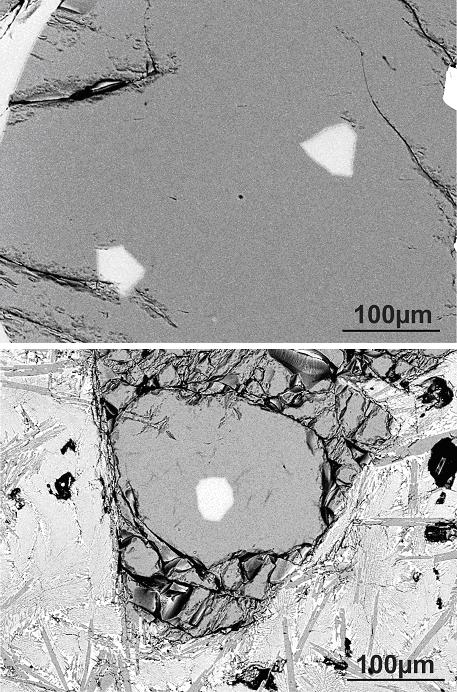2012 Annual Science Report
 University of Hawaii, Manoa
Reporting | SEP 2011 – AUG 2012
University of Hawaii, Manoa
Reporting | SEP 2011 – AUG 2012
Establishing the Source of Earth’s Water
Project Summary
Understanding the sources and delivery mechanisms of water to the Earth and the other terrestrial planets allows for the validation of planetary accretion models. This information can help us establish at what time the Earth contained sufficient water for the development of life. A key parameter in determining the source(s) of terrestrial planetary water is the hydrogen isotope composition of this water. However, hydrogen fractionation during surface and atmospheric processes on Earth changes the Deuterium/Hydrogen (D/H) ratio in the various water reservoirs. Therefore, to determine the primordial D/H ratio of Earth’s water we must find a reservoir that has been unaffected by these processes. Plate tectonics is known to drag surface water down into the crust and the upper mantle, but the transition zone and lower mantle are thought to be uncontaminated by surface water. The aim of this project is to sample hydrous minerals and melt inclusions sourced from these uncontaminated regions. We will then analyze these samples using the Cameca ims 1280 ion-microprobe at the University of Hawaii to produce a dataset that establishes the Earth’s primordial D/H ratio.
Project Progress
There are two main ways of attempting to measure the D/H ratio of the transition zone and/or the lower mantle. The first is to analyze hydrous melt inclusions found within primitive mantle plume phenocrysts. Certain mantle plumes, such as those that formed the Hawaiian Islands, Iceland, and Baffin Island, tap into a primitive deep mantle sources, and so D/H measurements of water in erupted lavas at these sites could give an accurate value for the Earth’s primordial water. However, lava degassing upon eruption and surface water contamination are difficult factors to avoid in these samples, and both processes could strongly affect the measured D/H ratio. Our D/H measurements of melt inclusions within Hawaiian Deep Drill Core pillow basalts have shown that these samples are compromised by surface water. But our methodology is now perfected, and we have moved on to analyze different sample sets, specifically Baffin Island and Icelandic basalts. Basalt samples from Midfell in southwest Iceland have been prepared and imaged, and numerous melt-inclusions identified as candidates for D/H analyses (Figure 1). Baffin Island samples have been kindly donated to us by Prof. Don Francis of McGill University, Montreal. We aim to analyze these samples after completion of the Midfell analyses.
The second way to attempt to measure the primordial terrestrial D/H ratio is to analyze hydrous primary mineral inclusions found in diamonds from the transition zone/deep mantle. The D/H ratio of these minerals would be extremely well protected from any surface water contamination or degassing because of their diamond casing. As long as the provenance of the diamond can be proved to be from the transition zone/deep mantle, and as long as the mineral inclusion formed at the same time as the diamond, the D/H ratios in these hydrous mineral inclusions will be incontestably primordial. Phlogopite diamond inclusions from the Yakutian, as described in Sobolev et al. (2009, Russian Geol. Geophys.), appear to be ideal for this proposed research, as their provenance is known and their size would allow for multiple analyses of one mineral grain. We are currently negotiating with Prof. Nicholas Sobolev (Sobolev Institute of Geology and Mineralogy) in the hope of analyzing a number of these samples in the coming year.

Backscattered electron images show the melt inclusions as bright irregular areas inside the olivine grains (darker grey).
Publications
-
Hallis, L. J., Taylor, G. J., Nagashima, K., & Huss, G. R. (2012). Magmatic water in the martian meteorite Nakhla. Earth and Planetary Science Letters, 359-360, 84–92. doi:10.1016/j.epsl.2012.09.049
-
Hallis, L. J., Taylor, G. J., Nagashima, K., Huss, G. R., Needham, A. W., Grady, M. M., & Franchi, I. A. (2012). Hydrogen isotope analyses of alteration phases in the nakhlite martian meteorites. Geochimica et Cosmochimica Acta, 97, 105–119. doi:10.1016/j.gca.2012.08.017
-
PROJECT INVESTIGATORS:
-
PROJECT MEMBERS:
Lydia Hallis
Project Investigator
Gary Huss
Co-Investigator
Karen Meech
Co-Investigator
Kimberly Binsted
Collaborator
Kazuhide Nagashima
Collaborator
Thorvaldur Thordarson
Collaborator
-
RELATED OBJECTIVES:
Objective 1.1
Formation and evolution of habitable planets.